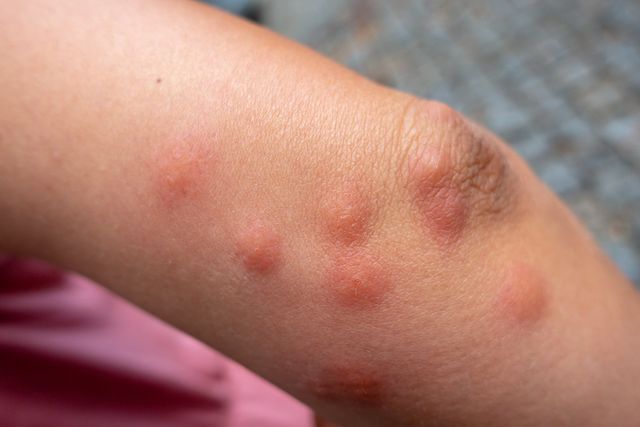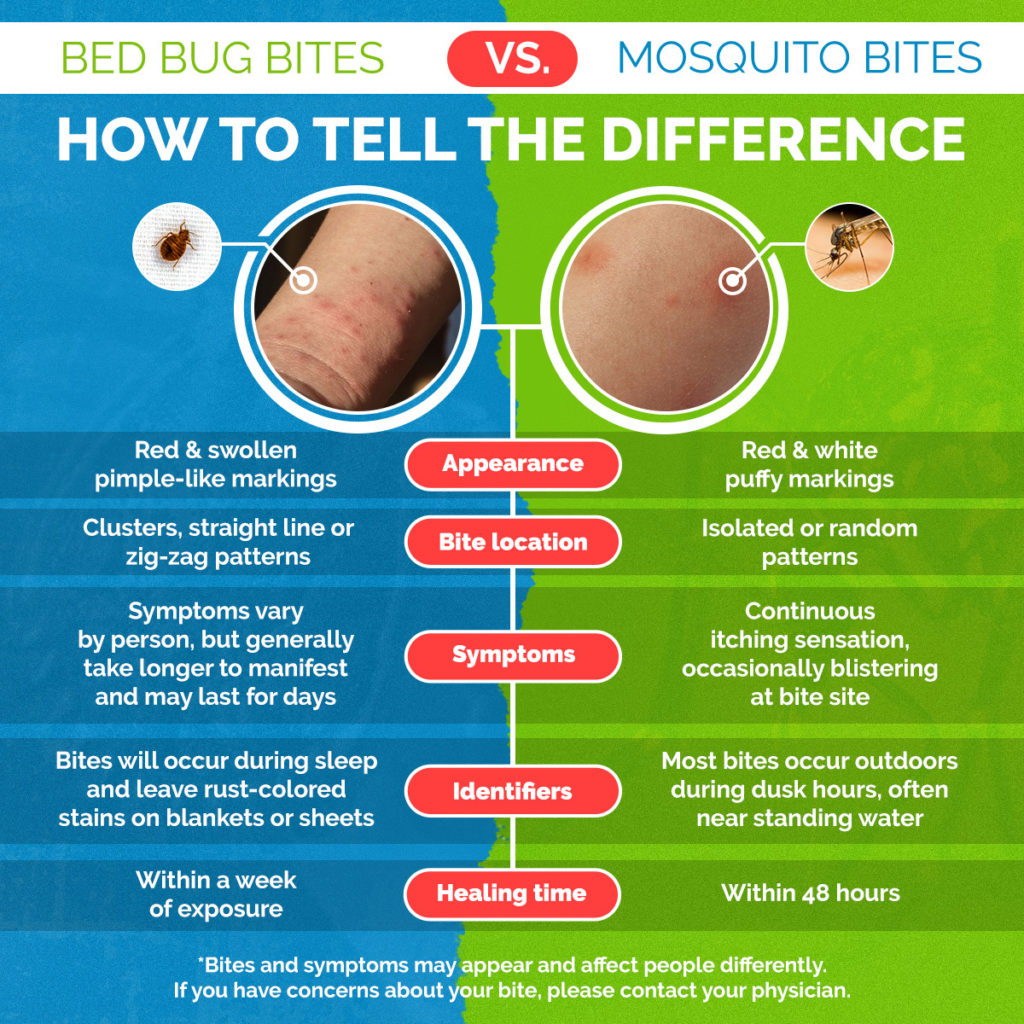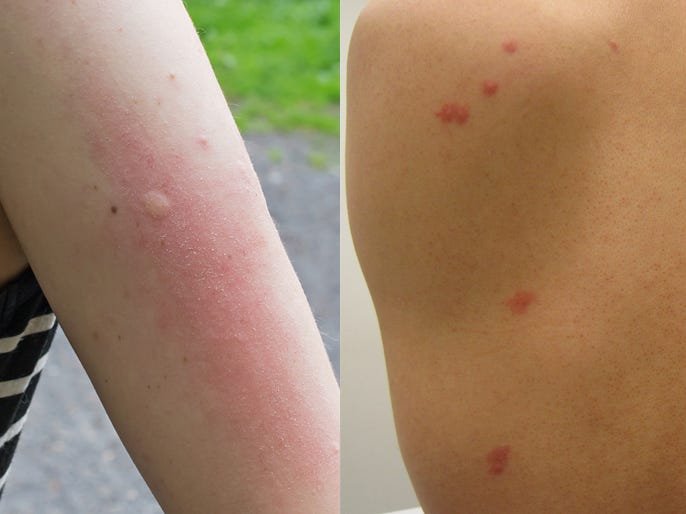Mosquito bites are usually isolated, appearing as puffy and reddish bumps, while bed bug bites occur in clusters, often in a distinct pattern such as a line or zigzag. Mosquito bites typically appear randomly over parts of the body, while bed bug bites tend to be in exposed areas during sleep, such as the ankles.
Are you waking up with mysterious bites and wondering whether they are from mosquitoes or bed bugs? Identifying the source of insect bites can be crucial for addressing the issue effectively. Mosquito bites and bed bug bites may seem similar at first glance, but there are distinct differences between the two.
Understanding these variations can help you take appropriate measures to address the situation. Let’s explore the unique characteristics of mosquito bites and bed bug bites to help you differentiate between the two.
Introduction To Bites And Itches
Distinguishing between mosquito bites and bed bug bites can be tricky. Mosquito bites typically appear as isolated bumps, while bed bug bites often occur in clusters or distinct patterns. Mosquito bites are itchy and red, while bed bug bites may be red, swollen, and sometimes accompanied by dark spots at the center.
Common Misconceptions
Many people mistakenly believe that all bug bites look and feel the same, leading to confusion and misdiagnosis. Understanding the differences between mosquito bites and bed bug bites is crucial for effective treatment and prevention.
Why It Matters
Distinguishing between mosquito bites and bed bug bites matters because it impacts the course of action for treatment and elimination. Misidentification can result in ineffective remedies and prolonged discomfort.

Credit: www.ecoguardpestmanagement.com
Characteristics Of Mosquito Bites
Mosquito bites usually appear as isolated bumps on the skin, while bed bug bites often occur in clusters and may be arranged in a line or zigzag pattern. Mosquito bites are itchy and puffy, while bed bug bites are red and swollen, sometimes with a dark spot in the center.
Appearance And Timing
Mosquito bites typically result in a puffy and reddish bump that appears within a few minutes of the bite. Alternatively, they may manifest as hard, itchy, reddish-brown bumps, or multiple bumps, appearing a day or so after the bite. It’s essential to note that mosquito bites can also present as small blisters instead of hard bumps.
Typical Reaction
Upon being bitten by a mosquito, individuals may experience itching, burning, and the development of fluid-filled blisters. The bites may also exhibit a dark spot at the center and appear in lines or clusters, with multiple bites grouped together. In some cases, individuals may find blood stains on their sheets from scratching the bites.
Understanding Bed Bug Bites
Bed bug bites typically appear in clusters and may be arranged in a line or zigzag pattern, while mosquito bites usually appear as isolated bumps on the skin. Bed bug bites also tend to be more inflamed and may have a dark spot in the center, whereas mosquito bites are often puffy and reddish.
Bite Patterns And Clusters
Bed bug bites usually appear in a cluster and often occur in a distinct pattern, such as a line or zigzag. These bites are usually found on areas of the body that are exposed during sleep, such as the arms, legs, and neck. The bites are typically small, red, and slightly swollen, with a dark spot at the center of each bite.On the other hand, mosquito bites are generally isolated and appear randomly over parts of the body that clothing does not cover. Mosquito bites are usually puffy and reddish in appearance, with a hard, itchy, reddish-brown bump. Small blisters may also occur instead of hard bumps.Nighttime Attacks
Bed bugs are nocturnal insects, which means they are active during the night and often feed on their hosts while they sleep. This is why most bed bug bites occur during the night. Mosquitoes, on the other hand, are active during the day and night and can bite at any time.If you wake up with bites that were not there when you went to bed, it is more likely to be bed bugs than mosquitoes. However, it is always best to confirm the presence of bed bugs by inspecting your bedding and surrounding areas.In conclusion, understanding the difference between bed bug bites and mosquito bites is crucial for proper identification and treatment. Bed bug bites usually appear in clusters and occur during the night, while mosquito bites are isolated and can occur at any time of the day. By knowing the difference, you can take the necessary steps to prevent and treat these bites.Physical Comparison
Distinguishing between mosquito bites and bed bug bites can be tricky. Bed bug bites often appear in clusters and follow a distinct pattern, while mosquito bites are typically isolated and randomly scattered on the body. The key difference lies in the appearance and grouping of the bites.
Color And Size Variations
Bed bug bites are often red and swollen with a dark center, appearing in clusters or lines. Mosquito bites are typically puffy and reddish, with no specific pattern.
Formation And Arrangement
Bed bug bites tend to be grouped together in a distinct pattern like a line or zigzag, often on exposed skin areas. Mosquito bites appear randomly on uncovered body parts.
Symptoms And Side Effects
Distinguishing between mosquito bites and bed bug bites can be challenging. Mosquito bites are single, itchy bumps, while bed bug bites often appear in clusters or lines. Bed bug bites may have a dark center, unlike mosquito bites, which typically swell and redden quickly.
Immediate Vs Delayed Reactions
immediatedelayed reactions, appearing hours or days later.Severity Of Itchiness
mildmoderateintensepersistent itching.When comparing mosquito bites to bed bug bites, it’s important to understand the symptomsside effects associated with each type of bite.Mosquito bites tend to show immediate redness and swelling, while bed bug bites can have delayed reactions, appearing hours or days later.In terms of itchiness, mosquito bites typically cause mild to moderate itching, whereas bed bug bites can lead to intense and persistent itching.Misidentification And Consequences
Distinguishing between mosquito bites and bed bug bites is crucial as it impacts the appropriate treatment. Mosquito bites typically appear as isolated bumps, whereas bed bug bites are often grouped in clusters or lines. Understanding the difference can help in identifying the source of the bites and taking necessary measures to address them effectively.
Risks Of Incorrect Treatment
Misidentifying mosquito bites as bed bug bites or vice versa can lead to incorrect treatment. If mosquito bites are mistaken for bed bug bites, the affected individual may take measures to eliminate bed bugs, such as throwing away infested bedding and furniture. Similarly, if bed bug bites are misidentified as mosquito bites, the individual may not take the necessary steps to eliminate the bed bug infestation. This can lead to further bites and increased discomfort. It is crucial to identify the type of bite correctly to ensure that the right treatment is administered.Preventing Infestations
Preventing mosquito bites can be achieved by using insect repellents, wearing protective clothing, and keeping windows and doors closed. On the other hand, preventing bed bug infestations requires a more proactive approach, such as regularly vacuuming and inspecting furniture, washing bedding and clothing in hot water, and using bed bug encasements. It is essential to take precautions to prevent infestations of both types of pests to avoid the discomfort and consequences of bites.In conclusion, misidentifying mosquito bites and bed bug bites can have severe consequences. It is essential to identify the type of bite correctly to ensure that the right treatment is administered, and infestations are prevented. Taking the necessary precautions to avoid mosquito bites and bed bug infestations is crucial. By doing so, individuals can avoid the discomfort and potential health risks associated with these bites.Treatment Methods
When it comes to treating mosquito bites and bed bug bites, different approaches are necessary due to the distinct nature of the bites.
Home Remedies
- Apply calamine lotion to reduce itching and irritation.
- Use a cool compress to alleviate swelling and discomfort.
- Try over-the-counter antihistamine creams or pills to relieve itching.
- Apply a paste of baking soda and water to reduce itching and inflammation.
- Use essential oils such as lavender or tea tree oil to soothe the skin.
When To Seek Medical Attention
If the bites become infected or if you experience severe allergic reactions such as difficulty breathing, dizziness, or swelling of the face, lips, or throat, seek immediate medical attention.

Credit: www.medicalnewstoday.com
Preventive Measures
Differentiating between mosquito bites and bed bug bites is important for effective preventive measures. Mosquito bites typically appear as isolated, puffy, and reddish bumps, while bed bug bites tend to occur in clusters and often in a distinct pattern, such as a line or zigzag.
Understanding these differences can help identify the source of the bites and take appropriate actions to address the issue.
Protective Practices
- Wear long-sleeved clothing and use insect repellent.
- Avoid outdoor activities during peak mosquito hours.
- Use bed bug-proof encasements on mattresses and pillows.
Environmental Controls
- Regularly inspect and vacuum sleeping areas.
- Reduce standing water around your home to prevent mosquito breeding.
- Keep your living spaces clutter-free to minimize bed bug hiding spots.
Conclusion: Steps To Take After A Bite
Differentiating between mosquito bites and bed bug bites can be challenging as they share similar symptoms such as redness, itching, and swelling. However, bed bug bites usually appear in clusters or lines, while mosquito bites are more isolated. If you suspect bed bugs, inspect your bedding and furniture and contact a pest control professional.
If you have multiple mosquito bites, apply a topical cream or take an antihistamine to alleviate symptoms.
Identifying The Culprit
After being bitten, it’s crucial to correctly identify the culprit to determine the appropriate course of action. Mosquito bites typically appear as raised, itchy, and red bumps that may develop a blister. On the other hand, bed bug bites often manifest as red, swollen welts with a darker center, often appearing in a linear or clustered pattern. By closely examining the characteristics of the bite, such as the arrangement and appearance, you can differentiate between the two.
Final Thoughts On Bite Management
Following a bite, it’s essential to take specific steps to alleviate discomfort and prevent potential complications. For mosquito bites, clean the area with soap and water, apply an anti-itch cream, and avoid scratching to prevent infection. In the case of bed bug bites, wash the affected area with mild soap, apply a cold compress, and consider using over-the-counter anti-itch creams. If symptoms persist or worsen, seek medical attention promptly to address any potential allergic reactions or infections.

Credit: www.carolinapest.com
Frequently Asked Questions
How Can You Tell The Difference Between A Bed Bug Bite And A Mosquito Bite?
Bed bug bites are red, swollen, with a dark center, in lines or clusters. They are itchy and may have fluid-filled blisters. Mosquito bites are isolated, puffy, reddish bumps, sometimes with small blisters and can be itchy and hard.
How Do You Tell If A Bite Is From A Bed Bug?
To identify a bed bug bite, look for red, swollen marks with a dark center, usually in lines or clusters. They may itch, burn, or form fluid-filled blisters and leave blood stains from scratching.
How Do You Know If It’s A Mosquito Bite?
To know if it’s a mosquito bite, look for a puffy and reddish bump that appears a few minutes after the bite. Mosquito bites can also cause hard, itchy bumps or small blisters. Bed bug bites, on the other hand, are usually arranged in lines or clusters and may have a dark spot at the center.
Mosquito bites are generally isolated and appear randomly over parts of the body that clothing does not cover.
Conclusion
Distinguishing between mosquito bites and bed bug bites involves examining bite patterns. Mosquito bites typically appear isolated, while bed bug bites are clustered together. Understanding these differences can help in identifying the culprit and taking appropriate action for relief.
Related posts:

I’m MD Tanvir, and I bring years of expertise gained from working closely with pest control companies to the forefront. My journey in the industry has inspired me to launch Bug Battler, a platform aimed at equipping people with the know-how to combat pests autonomously. Through Bug Battler, I aim to empower individuals with practical insights to tackle pest infestations effectively.

